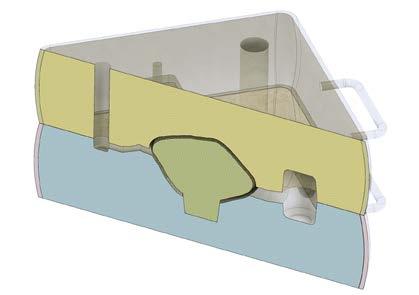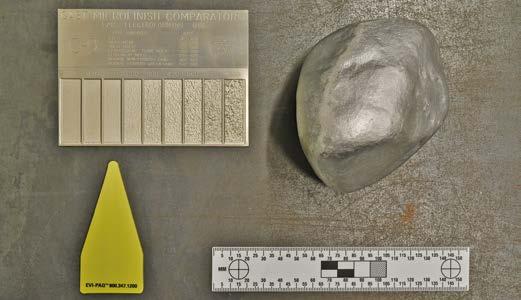
7 minute read
Cultivating a digital dialogue for casting
Affiliation: Bartlett School of Architecture at University College London
In our first article “Jean Prouvé: an aluminium pioneer” (Aluminium News, Dec 2019) we gave a historical account of the famous Aluminium Centenary Pavilion by the French constructor Jean Prouvé from 1954, an example from the Twentieth Century of what is possible in the design of our built environment when a designer worked with a comprehensive knowledge of the industrial production technology available at the time. In our follow-up article “UCL @ HereEast: A fun-palace for fabrication design and research” (Aluminium News, March 2020) we described a large-scale collaborative facility dedicated to supporting an approach to design for the built environment that connects the design studio to the point of industrial production with Twenty-first Century technology. Together with Professor Michael Stacey with whom I co-authored those two articles, the Bartlett School of Architecture have since agreed a Memorandum of Understanding (MOU) with the Aluminium Federation in which one of the key objectives is to promote excellence in design and the advancement of expertise in the use of Aluminium for manufacturing within the construction sector. This article focusses on working with the technique of casting molten metal into green-sand moulds through a pedagogic perspective with a group of students taking the Masters in design for manufacture at the Bartlett led by Emmanuel Vercruysse, the programme’s director. The focus on casting was motivated by a range of considerations, the observation that many functional parts of buildings and structures such as connector joints, furniture components and architectural fittings often consist of sculpted geometry. Beyond examples by Prouvé, we admired other famous historical precedents such as the connector components made for the IBM travelling pavilion designed by the Renzo Piano building workshop with engineering firm ARUP completed in 1984. We developed an empathy for how sculpted geometries were strongly differentiated in the trade-off between subtractive processes from stock material using CNC (Computer-NumericallyControlled) milling and the potential for comparatively minimal material waste from casting into green-sand moulds. We were also driven by exploring the potential to maximise resource utilisation and the potential for design for remanufacture within the framework of a circular economy using casting given the low-temperature melting-point of Aluminium (BSi, 2018). We also recognised the potential for applying design for manufacture principles to lower part-count through feature consolidation and careful separation of different alloys such that at the end of service, the construction can be disassembled and material recovered for contribution to high-purity waste-streams.
We also sought to calibrate the quantification of production volume to the scale of a single building project that might only need 10’s or low 100’s of bespoke components using the greensand cast technique and not the 1,000’s and 10,000’s that might be needed to justify one die-cast. A workflow for casting was developed by the design tutors in close collaboration with workshop staff for safe and practical hot-working in an educational environment, while also establishing logical terms of reference for the students to explore geometric arrangements. The workflow consisted of design intent expressed with hand-sketches that were then developed and analysed through digital models. Software for geometry modelling such as Rhino 3D and dedicated manufacturing software such as Autodesk Fusion 360 were used to generate, explore and analyse geometry. This provided a basic digital tool-set to test the feasibility of casting by studying draft angle, compensating for volumetric shrinkage during cooling and produce 3D printed and CNC milled patterns with sufficiently precise size, form and orientation tolerances. The digital tools supported the workflow with a “manufacturing model” that expressed the desired Near Net Shape (NNS) while modelling the sacrificial datum features and work-holding zones necessary for projecting precision machining selectively post-cast in order to achieve the functional requirements. This also included metrology inspection to verify compliance with the design geometry and mating interfaces necessary for final assembly as a kit-of-parts. A C-9 microfinish visual comparator was used to assess areal surface finish, showing results at the finer end of the roughness range typically for casting into green-sand moulds within (300 to 560) micro-inches or (7.6 to 14.2) μm. We have been adopting the Geometric Product Specification (GPS) framework and its rules of interpretation standardised in ISO documents to develop literacy for unambiguously expressing the functional requirements for cast parts. Specifically, how Theoretically Exact Dimensions (T.E.D.) in the CAD file describes the NNS
• Above: Set of patterns for cope, drag core box to sand mould the “Pebble” project by Melis
Van Den Berg (2021)” • Above: Section analysis through solid model of casting flask using Autodesk Fusion 360 software by Melis Van Den Berg (2021)

of the pattern to be cast, but GPS is used to account for material shrinkage during cooling and thermal distortion of the shape the three-dimensional tolerances are generous. Given the shrinkage inward from the NNS, we made extensive use of the UZ (Unequal Zone) modifier to express the desired three-dimensional form that could be verified by three-dimensional surface-scanning. From this, Datum features are established to coordinate the projection of precision turning, milling and drilling operations onto the parts post-cast using the specifications and basis for interpretation in (BSi, 2017). We recognise the deep well of experience that builds up from years of practice producing varied foundry work projects, this is experience and know-how that is not captured in the features within digital tools in common usage by architectural designers. However, we would argue that merely using digital tools to translate sketches of design intent into printable patterns and moulds is also impoverishing limited. As such, we are motivated to exploit the range of analytical tools that are available in existing digital tools to provide useful terms of reference. Moreover, activities in UCL @ HereEast pursue the curation of digital tool-chains that facilitate a bi-directional flow of information between design intent that is expressed with functional specifications through the manufacturing process to the measurement of the parts produced. With this approach, we aspire that students acquire literacy in the process parameters to lead a meaningful dialogue between designer, maker and inspector. On the basis that the application of systematic methods gives a structure to seek and identify value, it provides terms of reference between the stakeholders and perhaps most usefully it supports the effective communication and negotiation of value propositions that such an approach can identify in a digital dialogue for casting.
About the authors: Dr Christopher Leung is an architect at the Bartlett School of Architecture undertaking research into industrial manufacturing for the construction sector. Emmanuel Vercruysse directs the Masters in Design for Manufacture at the Bartlett School of Architecture in University College London (UCL).
Acknowledgements The authors wish to express their thanks to Melis Van Den Berg who is a Lecturer teaching design at the Bartlett School of Architecture and William-Victor Camelleri who is a Lecturer in Numeric Manufacturing teaching on the Masters in Design for Manufacture and is pursuing a Ph.D in architecture by design. Special thanks to the (2020-2021) cohort of students on the M.Arch in Design for Manufacture course at the Bartlett School of Architecture. References
British Standard 8887-3, (2018), “Design for manufacture, assembly, disassembly and end-oflife processing (MADE) Part 3: Guide to choosing an appropriate end-of-life design strategy”, British Standards Institute, London, ISBN-13: 978-0-5805-1403-6.
Ammen, C. W. (1982), “The Complete Handbook of Sand Casting”, McGraw-Hill, Blue ridge summit, ISBN-13: 978-0-8306-1043-3.
Chap. 3, “Component Design”, (2001), Stacey, Michael, Architectural Press, ISBN-10: 0-7506-0913-3.
Ammen, C.W., (1985), “Casting Aluminium”, Blue Ridge, Tab Books, ISBN-10: 0-8306-1910-0. British Standard 8062-4 (2017) Geometrical product specifications (GPS) Dimensional and geometrical tolerances for moulded parts Part 4: General tolerances for castings using profile tolerancing in a general datum system, British Standards Institute, London, ISBN-13: 978-0-5807-8863-5. Leung, C., (2020), “Model-Make-Measure: Connecting the studio to the workshop”, Industry Talk Session 463685, AU 2020, Autodesk Inc, Online: https://www.autodesk.com/autodeskuniversity/class/Model-Make-Measure-ConnectingStudio-Workshop-2020 Voelker, M. M. and Peters, F. E., (2017), “Development of a Digital Standard to Specify Surface Requirements of Cast Metal Surfaces,” Materials Performance and Characterization, Vol. 6, No. 2, pp. 130–143, http://dx.doi. org/10.1520/MPC20160014 , ISSN: 2165-3992.

• Above: The hollow Pebble cast in Aluminium
• Right: Cast and machined component for shelter project by students on the design for manufacture course (2021)











